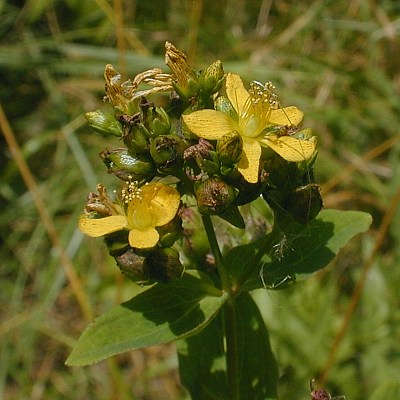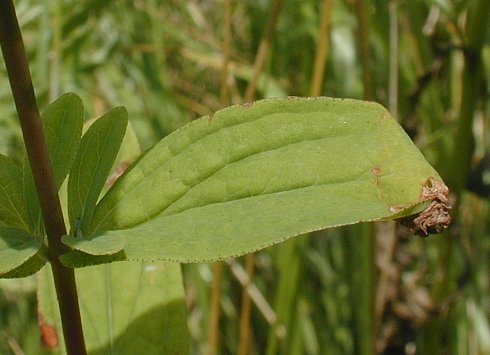Description: This perennial plant is up to 2½' tall, branching occasionally in the upper half. The hairless stems are red or green. The hairless opposite leaves are up to 2½" long and 1" across. They are oblong, oval, or bluntly lanceolate (with rounded tips), with a few pinnate or parallel veins and smooth margins. The leaves are often sessile or perfoliate, otherwise they have short petioles. Scattered translucent dots are observable on the underside of the leaves. Smaller leaves often appear in the upper axils of the larger leaves on major stems. Many of these stems terminate in tight clusters of yellow flowers. Each flower is a little less than ½" across, and has 5 petals. In the center, is a flask-shaped pistil that is surrounded by numerous yellow anthers on long styles. Numerous small dark dots can occur anywhere on the surface of the petals or the buds, often appearing in streaks. There is no floral scent. The blooming period occurs during mid-summer and lasts about a month. The seedpods split into 3 sections, exposing numerous tiny seeds, which are scattered by the wind when the stems sway back and forth. The root system consists of a branching taproot and short rhizomes. Vegetative colonies of this plant can develop from the rhizomes.

Cultivation:
The preference is full or partial sun, moist to mesic conditions, and a
rather lean soil, which reduces competition from taller plants. Rocky
or gravelly soil is quite acceptable. Occasionally, the leaves turn
brown in response to drought, otherwise this plant has few problems.
Range & Habitat:
Spotted St. John's Wort occurs in every county of Illinois, where it is
fairly common and native (see Distribution
Map). Habitats include moist to mesic black soil prairies,
gravel prairies, open woodlands (rocky and otherwise), savannas,
woodland borders, thickets, clay banks along rivers or lakes, and areas
along roadsides and railroads.
Faunal Associations:
The flowers attract long-tongued and short-tongued bees, including
bumblebees and Halictid bees. Beetles and Syrphid flies may also visit
the flowers, but they are less effective pollinators. The reward of
these insects is the abundant pollen, as the flowers produce no nectar.
The caterpillars of the butterfly Strymon melinus
(Gray Hairstreak) reportedly eat the seed capsules, while the
caterpillars of the moth Nedra ramosula (Gray
Half-Spot) feed on the foliage. Mammalian herbivores usually don't
consume this plant because the leaves contain hypericin – a
photosensitive toxin. Light-skinned animals are especially sensitive to
this toxin, which can cause the skin to blister in sunlight. It can
also cause gastrointestinal irritation.

Photographic
Location: The photographs were taken at Judge
Webber Park in Urbana, Illinois.
Comments:
The easiest way to distinguish Spotted St. John's Wort from other
similar species involves an examination of the flower petals. Dark dots
and streaks can appear anywhere on the upper surface of the yellow
petals, whereas for other species of St. John's Wort such dots and
streaks are confined near the margins of the petals, or they are
completely absent. The common name of this plant refers to the feast
day of St. John, which was celebrated in Medieval Europe at the time of
the summer solstice (late June). This corresponded to the time when the
European species Hypericum perforatum (Common St.
John's Wort) typically blooms, and so the saint and
wildflower became associated together.